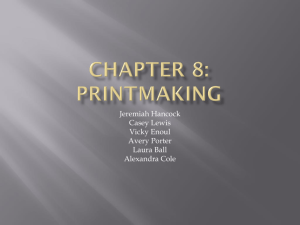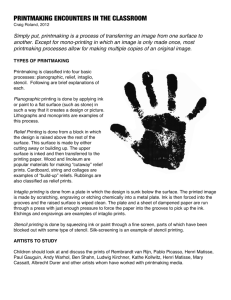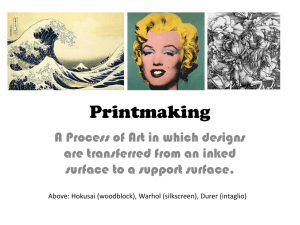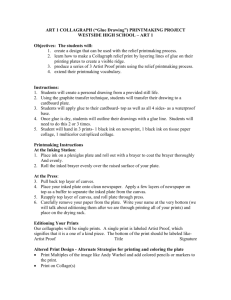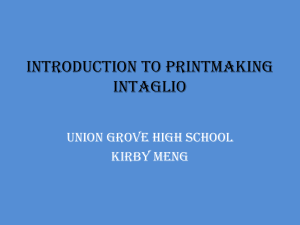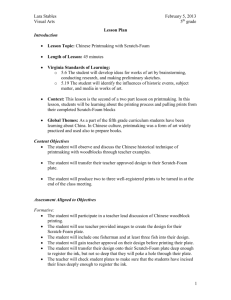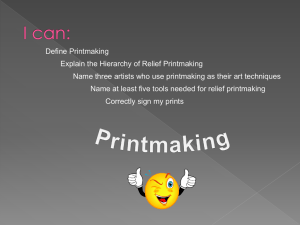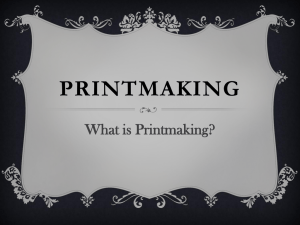PRINTMAKING TERMS
advertisement
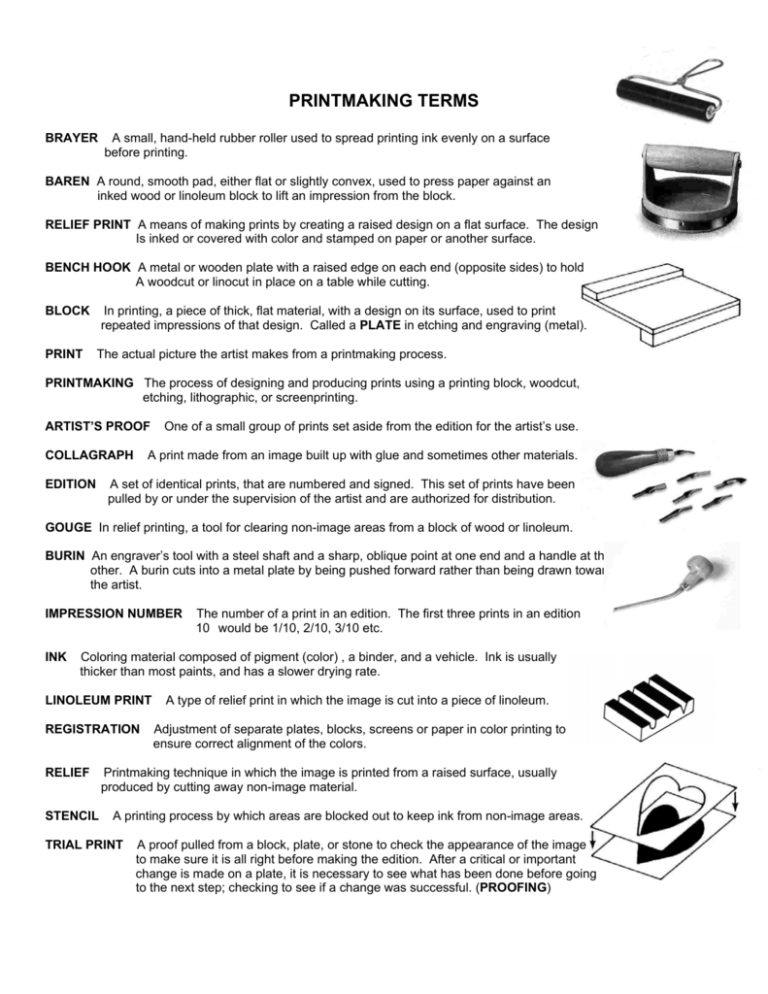
PRINTMAKING TERMS BRAYER A small, hand-held rubber roller used to spread printing ink evenly on a surface before printing. BAREN A round, smooth pad, either flat or slightly convex, used to press paper against an inked wood or linoleum block to lift an impression from the block. RELIEF PRINT A means of making prints by creating a raised design on a flat surface. The design Is inked or covered with color and stamped on paper or another surface. BENCH HOOK A metal or wooden plate with a raised edge on each end (opposite sides) to hold A woodcut or linocut in place on a table while cutting. BLOCK PRINT In printing, a piece of thick, flat material, with a design on its surface, used to print repeated impressions of that design. Called a PLATE in etching and engraving (metal). The actual picture the artist makes from a printmaking process. PRINTMAKING The process of designing and producing prints using a printing block, woodcut, etching, lithographic, or screenprinting. ARTIST’S PROOF COLLAGRAPH EDITION One of a small group of prints set aside from the edition for the artist’s use. A print made from an image built up with glue and sometimes other materials. A set of identical prints, that are numbered and signed. This set of prints have been pulled by or under the supervision of the artist and are authorized for distribution. GOUGE In relief printing, a tool for clearing non-image areas from a block of wood or linoleum. BURIN An engraver’s tool with a steel shaft and a sharp, oblique point at one end and a handle at the other. A burin cuts into a metal plate by being pushed forward rather than being drawn toward the artist. IMPRESSION NUMBER INK The number of a print in an edition. The first three prints in an edition 10 would be 1/10, 2/10, 3/10 etc. Coloring material composed of pigment (color) , a binder, and a vehicle. Ink is usually thicker than most paints, and has a slower drying rate. LINOLEUM PRINT REGISTRATION RELIEF STENCIL A type of relief print in which the image is cut into a piece of linoleum. Adjustment of separate plates, blocks, screens or paper in color printing to ensure correct alignment of the colors. Printmaking technique in which the image is printed from a raised surface, usually produced by cutting away non-image material. A printing process by which areas are blocked out to keep ink from non-image areas. TRIAL PRINT A proof pulled from a block, plate, or stone to check the appearance of the image to make sure it is all right before making the edition. After a critical or important change is made on a plate, it is necessary to see what has been done before going to the next step; checking to see if a change was successful. (PROOFING) MONOPRINT (monotype) A print pulled in an edition of one. There is no series of identical prints that are signed and numbered. It is actually an image usually painted on glass or plexi-glass, and transferred ( or stamped) on paper. ENGRAVING When lines are cut into a metal plate with a V-shaped tool called a burin; ink is then forced into these lines and wiped from the flat surface of the plate, which is then printed with paper that has first been soaked in water and then blotted. The damp paper is forced down into the grooves, where it picks up ink. ETCHING A drawing is scratched through a wax-covered or tar covered metal plate which is then Placed in acid that eats into the exposed areas that were scratched forming shallow grooves. The plate is cleaned and inked; ink is cleaned from all areas except the grooves. Printing Paper that has been soaked in water and then blotted is forced through a press against The plate; the damp paper is forced down into the grooves, where it picks up ink. INTAGLIO PRINTING (an Italian term) the ink is deposited below the surface of the plate which has been corroded, scratched, or incised, and the surface wiped clean; a damp paper is forced into the surface in a press. REDUCTION BLOCK PRINT When one block is printed several times, removing a portion and changing Color each time (working from lightest to darkest and registration is critical) PRINTING PRESS A device used by a fine art printmaker to produce prints one copy at a time. It applies pressure between a sheet of paper and an inked printing plate. Presses for intaglio printing apply considerable pressure as they force the paper and plate between a roller and a flat bed, thus squeezing the paper into the inked grooves of the plate. SILKSCREEN A print made by forcing ink through a stencil attached to a woven mesh. The screen has Certain areas blocked out to prevent ink from getting through those areas. Today cheaper Fabrics are used and because silk is not usually used, the more generic name screen print May be more appropriate. The term serigraph is meant to designate a fine art of screen Prints on paper. The stencil may be painted on by hand or done photographically.


